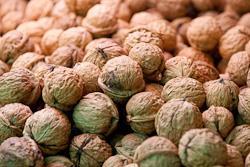
US walnut exports to Asia – China in particular – have rocketed this year on the back of a promotional push and a record-breaking crop California, the hub of US nut production.
Since beginning its marketing efforts in China in 2008, California’s walnut exports to the market have risen 53 per cent for shelled nuts and 12 per cent for nuts in the shell, reported the Sacramento Bee.
California’s walnut crop is expected to be a record-breaking 462,700 tonnes this year (510,000 short tons) – a 17 per cent rise on the previous season – of which around 55 per cent will be exported.
China is one of the fastest-growing markets for the nuts, aided by funds from the US federal government’s Market Access Programme, which gives out about US$200m in funding annually to US agricultural groups for export market development.
“The grants really help to build markets for our products, especially in China, where the population continues to grow and people are getting wealthier,” Michelle McNeil, senior marketing director for the California Walnut Board & Commission’s international division, told the Sacramento Bee. “We use the grants to reach consumers with educational seminars, materials on where to buy and how to use them.”
One of the keys to increased sales of US walnuts in China has been the use of the product in moon cakes. Promotions to Chinese bakeries have positions Californian walnuts as a premium product, and increased their use in the popular cake.
Exports to China and Hong Kong last year hit around 26,500 tonnes.
Other markets in Asia are also seeing increasing volumes; Japan and South Korea imported 11,000 tonnes and 9,400 tonnes last year respectively, sources told Fruitnet.com. While China is primarily an in-shell walnut market, Japan and South Korea prefer shelled nuts.
Funding from the Market Access Programme (MAP) has been fundamental to the expansion of US walnut exports to Asia. The industry received around US$5m in promotional funding in 2010.
Between the MAP and other programmes, such as the Emerging Markets Programme (EMP), Foreign Market Development Programme (FMD), Quality Samples Programme (QSP) and Technical Assistance for Specialty Crops Programme (TASC), the US agriculture sector received US$234.5m in government funding in 2009.
While US agricultural subsidies have drawn fire in the past, market development funding has proven very effective for the country. For every US$1 spent on promotion and market development, US food and agriculture exports grow by US$35, USDA Foreign Agricultural Service spokesman Matthew Herrick told the Sacramento Bee.
The MAP was last month listed on the federal government’s list of potential cuts by the debt reduction commission, but the axe seems to have been lifted from its neck as part of President Barack Obama’s goal to boost US exports.
“The President has made expanding US exports a priority and these programmes are an integral part of this plan,” said Agriculture Secretary Tom Vilsack
“These market development programs provide opportunities to organisations working on behalf of America’s farmers to expand US exports as part of the President’s National Export Initiative.”






No comments yet